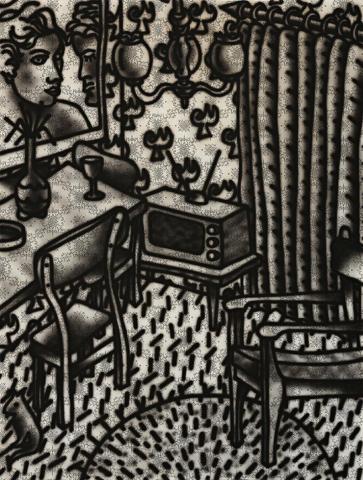SUBURBAN, 1983
HOWARD ARKLEY
synthetic polymer paint on wallpaper on canvas
160.0 x 121.0 cm
signed, dated and inscribed verso: Howard Arkley / Title SUBURBAN / Date: 1983 ...
Roslyn Oxley9 Gallery, Sydney
Private collection, Sydney
Howard Arkley: Recent Works, Roslyn Oxley9 Gallery, Sydney, 15 June – 2 July 1983, cat. 5
ANZART at Edinburgh, Richard Demarco Gallery, Edinburgh, United Kingdom, August 1984
Meaning & Excellence, George Paton Gallery, University of Melbourne, Melbourne, February 1985
Brown, R., 'Spraying the Suburban Dream: Howard Arkley – Development of his artistic style', Tension, no. 18, Melbourne, Virgin Press, October 1989, p. 24, (illus. as Suburban Interior)
Arkley Works electronic catalogue raissoné: http://arkleyworks.com/?p=1322
There can be little dispute. Howard Arkley did not see the suburbs the way the rest of us do. He was like Alice down the rabbit hole, surrounded by wonders, fears, magic and weirdness, the world around him pulsating with potential. A boring suburban living room, like the one depicted here, was a broiling mass of shapes and objects, an alchemists' dream. A suburban interior was a world of mystery and Arkley was the wizard to bring it all to life.
This work was executed in the early 1980s, thus early in his career. But it was an explosive time in Melbourne, a period when new galleries and magazines and nightclubs blossomed. A nascent punk scene was emerging and art schools were buzzing with energy, with such teachers as Arkley leading the helm. And there were youthful curators who recognised this explosion of energy such as Denise Robinson, who, in 1984, curated the immensely significant exhibition, 'Meaning & Excellence' - Australian artists at the Edinburgh International Festival.
Robinson was an early supporter of Arkley's work and he was an inevitable inclusion in her powerful show. In many respects this was an exhibition that captured much of the core of Arkley's generation, gathering together many of his peers such as Vivienne Shark LeWitt, Peter Tyndall, Linda Marrinon and Robert Rooney.
Robinson included Suburban, 1983 which had been exhibited at the Roslyn Oxley9 Gallery in Sydney and Arkley's career was on the upward spiral that is now the stuff of history.
It is not difficult to see why when contemplating this work. The hand of the artist suggests an assuredness and maturity that belied his youthfulness. It is the work of an artist in total control of his language. Every centimetre is utilised to balance what in theory is a chaotic tableaux. It is a clearly obsessive work, as though if any element were removed the entire room would collapse. His fascination with both 1950s and 1960s furnishings - the kind of kitsch detritus that often furnished his early studios - is a prominent element, but so too is his obsession with the faux Rococo and Baroque simulacra that one can still find in Op Shops in Prahran and St. Kilda - the garish light fitting (no doubt fake brass) and dated wine goblet (no doubt fake gold) on the table.
Texture was everything to Arkley and this is an early example of what would become a central stylistic trend; the bewildering geometric slashes that adorn the carpet, the polkadot pattern of the curtain and the grid that embellishes the lounge chair. But a less formal balancing element can be spied decorating the wall, his picture within a picture. For all his love of modernist movements, Arkley, as both teacher and artist, had respect for history and this, almost without doubt, is a portrait of Narcissus who was renowned for both his beauty and his high self-regard, gazing at himself in a wonderfully ramshackle Aussie living room.
ASHLEY CRAWFORD
